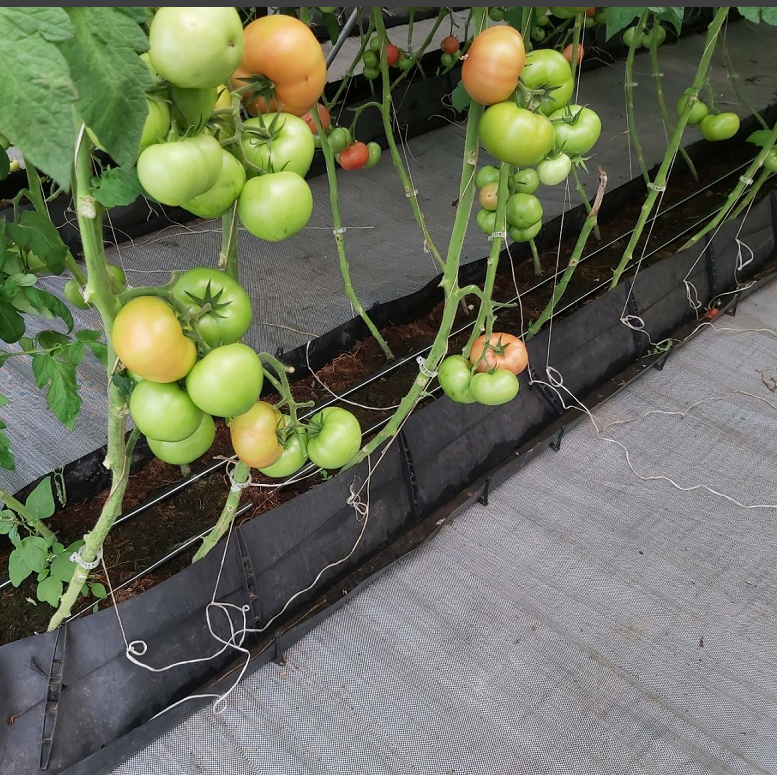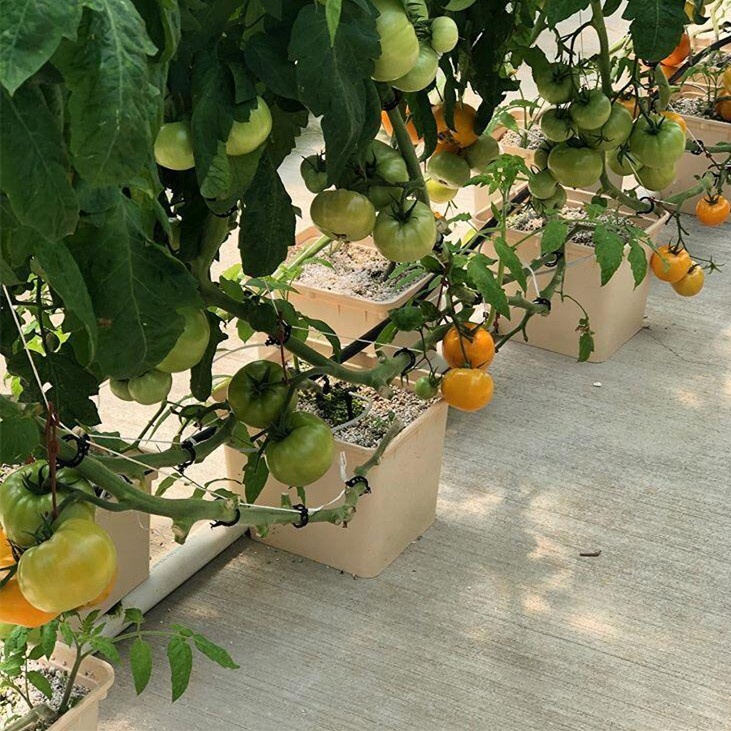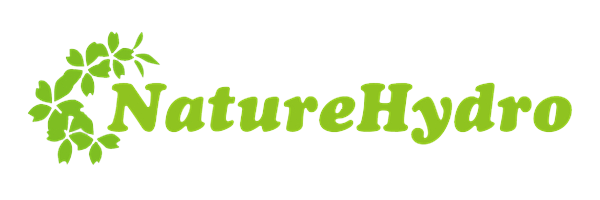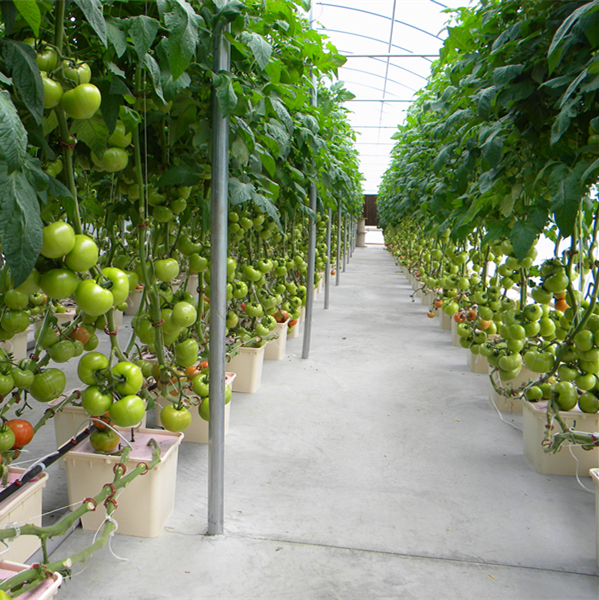In our daily life, we often buy high-quality tomatoes in supermarkets or markets. It can not only cook and fry, but also make soup, cold mix and raw food. It contains a lot of vitamins and various minerals. It is a vegetable that can be eaten by all age groups. With the advancement of agricultural industrialization, no matter what kind of crops are planted, the relevant technologies are changing with each passing day, and planting tomatoes is no exception. At present, in addition to traditional soil cultivation, hydroponic tomato is also a trend in tomato planting.
Soilless cultivation includes hydroponic culture, fog culture and substrate culture. Substrate culture is suitable for soilless cultivation of tomatoes. The form of matrix is similar to soil, but not soil. The commonly used substrate is coconut bran substrate or peat substrate. The substrate itself has no nutrition and mainly plays the role of fixing tomato seedlings. However, the basic nutrients of the substrate can meet the growth of seedlings. In the later stage, liquid fertilizer is needed to increase the nutrients in different periods. The fertilization of substrate cultivation is carried out by drip irrigation system, which is also known as the integrated irrigation system of water and fertilizer. According to different growth stages, there are different fertilization conditions. It is directly injected into the drip irrigation system through the fertilization pump and directly transported to the root of tomato to ensure the absorption of tomato.
There are no substrate and drip irrigation systems for tomato cultivation. For the growth and yield of tomatoes, professional planting technology is still needed to ensure.

Cultivate strong seedlings
The tomato seedling raising period can be determined according to the family conditions. Generally, the extreme minimum temperature is not lower than 5 ℃. The combination of sponge block and planting basket can be used for home tomato germination and seedling raising. This method has the advantages of cleanness and sanitation, and the seedlings can be directly transferred to the hydroponic device. The seeds should be disinfected before germination. The seeds can be soaked in warm soup, soaked in warm water at 50 ~ 55 ℃ for 20 minutes, and then soaked in water at 20 ~ 30 ℃ for 4 ~ 6 hours. Then put the seeds into the sponge block, and then put the sponge block into the planting basket. Put the planting basket in a shallow plate with water, cover it with fresh-keeping film for moisturizing and heat preservation, and promote germination in the shading place.
In the early stage of germination, only clean water is needed to ensure seed germination. When the cotyledons expand and grow 2 ~ 3 heart leaves, place the planting basket in a glass bottle added with low concentration nitrogen fertilizer aqueous solution to expand the roots and leaves. When the roots extend to about 20cm, they can be transplanted into the hydroponic device.
Hydroponic process
The tomato hydroponic device adopts a black bucket with a cover, with a specification of 15 ~ 20L, and 3 ~ 4 plants can be planted in each bucket. Drill 3 ~ 4 planting holes on the barrel cover at an equal distance to place the planting basket, and drill a small hole next to it to place bamboo poles and other supports.
At present, there are a variety of nutrient solution formulations for tomato hydroponic culture, including Japanese Garden trial formula, HOAGLANDS formula, Yamazaki formula and the formula of many agricultural colleges and universities in China. Based on the Japanese Garden trial formula, this study detected the plant growth status under different hydroponic nutrient solutions, and optimized the formula of barreled tomato hydroponic nutrient solution.
Through the comparative test, it is found that the leaves of the original formula plants are dark green and curly, with large leaf area and thick leaves, and the initial flowering period is later than that of other plants. The reason is that the nitrogen content in the original formula is high, the plants are greedy for green and grow in vain, the vegetative growth is excessive, and the reproductive growth is delayed. In the fruit setting stage after flowering, 0.05% borax was sprayed in combination with topdressing outside the root to promote fertilization and protect flowers and fruits; Spraying 0.1% calcium superphosphate during fruit expansion promoted flower bud differentiation and fruit development, and had a certain preventive effect on umbilical rot.
By optimizing the comparative test, the dosage of calcium nitrate in the original nutrient solution was reduced to 900MG / L, and calcium superphosphate was applied after fruit setting; The dosage of ammonium dihydrogen phosphate was reduced to 140mg / L, and the EC Value in the nutrient solution was detected regularly, and the pH remained about 6.8.
Since 3 ~ 4 tomatoes are planted per barrel, single stem pruning shall be adopted during pruning. Except for the growth point, all other side branches shall be removed, leaving 3 ~ 4 ears of fruits to pick the heart, and 2 ~ 3 leaves shall be left on the uppermost ear of the plant. After the fruit is green and ripe, the senescent leaves at the lower part of the plant shall be removed to facilitate ventilation and light transmission. For varieties with small single leaf area and slow decline of leaf photosynthetic capacity, more leaves can be reserved appropriately. Insert a bamboo pole next to each tomato and tie a vine at the lower part of each ear of fruit.
Physiological diseases and control of tomato fruit
1. Malformed fruit
Malformed fruits are called malformed fruits, such as oval fruit, multi heart fruit, top split fruit, etc. the direct reason is that there are too many ovary ventricles. If low temperature, excess nutrition of nitrogen and phosphorus and hormone application are encountered in the seedling stage, malformed fruits can be produced. Measures such as increasing temperature at seedling stage, reducing the content of nitrogen and phosphorus in nutrient solution at seedling stage and the use of hormones can be taken to prevent the occurrence of abnormal fruits.
2. Hollow fruit
From the appearance, most of its cross sections are polygonal. When cutting the fruit, it can be seen that there is a lack of sufficient colloid between the pulp and the placentation, and there is an obvious cavity in the seed. The main causes were poor pollination and fertilization; Excessive nitrogen, less potassium, weak light in nutrient solution, and excessive vegetative growth of plants; Fruit setting hormone dipped in flowers too early or the concentration was too high; The number of ovary ventricles of tomato varieties is too small, or the number of ovary ventricles is too small due to high temperature, weak light and insufficient nutrition in seedling stage.
The main control measures are to select varieties with more ovary ventricles; Prevent excessive nitrogen fertilizer and insufficient light in nutrient solution; Use fruit setting hormone correctly and avoid excessive concentration or application in bud stage; During seedling raising, the temperature management should be appropriate to avoid high temperature and insufficient nutrition and light; Do not pick the heart too early.
3. Navel rotten fruit
The onset period is mostly on young fruits the size of walnuts to the size of eggs. At the beginning of the onset, small yellowish brown spots appear near the navel, and then change from oil stains to dark brown, concave inward and hardened. When the disease is not serious, the fruit can grow and mature, otherwise the fruit will stop expanding and coloring in advance.
The direct cause of navel rot is calcium deficiency. However, there are many reasons for calcium deficiency in plants, mainly due to the high content of potassium, nitrogen and other elements, which inhibit the absorption of calcium by plants; The pH of nutrient solution is too low; High temperature inhibited the absorption of calcium and the movement of calcium in plants.
The main control measures are to avoid excessive nitrogen in nutrient solution; In case of navel rot, spray 0.5% calcium chloride or 0.1% calcium superphosphate for several times.
4. Tendon rotten fruit (strip rotten fruit, strip spotted fruit)
There are two kinds of gluten rot fruit, brown and white. The symptoms of browning type tendon rot fruit are uneven fruit surface, local browning and necrosis; If the disease is mild, the appearance of the peel is still good, but the color of the disease is poor, the pulp becomes hard, and there are often cavities in the fruit, which greatly reduces the value of the commodity. The symptoms of white deformed gluten rotten fruit are that the diseased part of the pericarp has waxy luster and hard quality, the pulp is in the shape of bran core, and the diseased part is poorly colored and slightly yellow.
The main causes of gluten rotten fruit are low temperature and weak light, poor ventilation, excessive ammonium nitrogen and insufficient potassium fertilizer. Corresponding control measures can be taken according to the causes.

Future outlook
With the improvement of living standards, more and more people are interested in balcony vegetables or home gardening. The dream that originally needed land can be realized can now realize the production of vegetables indoors, feel the charm of plant growth and taste their own labor achievements. The continuous promotion of hydroponic technology solves the problems of soil diseases and insect pests and microbial transmission, purifies the indoor environment, and feels the whole process of plant growth and development from germination and seedling raising to plant growth, flowering and fruiting and fruit ripening. It has both sensory harvest and spiritual cultivation.
Post time: Mar-23-2022


